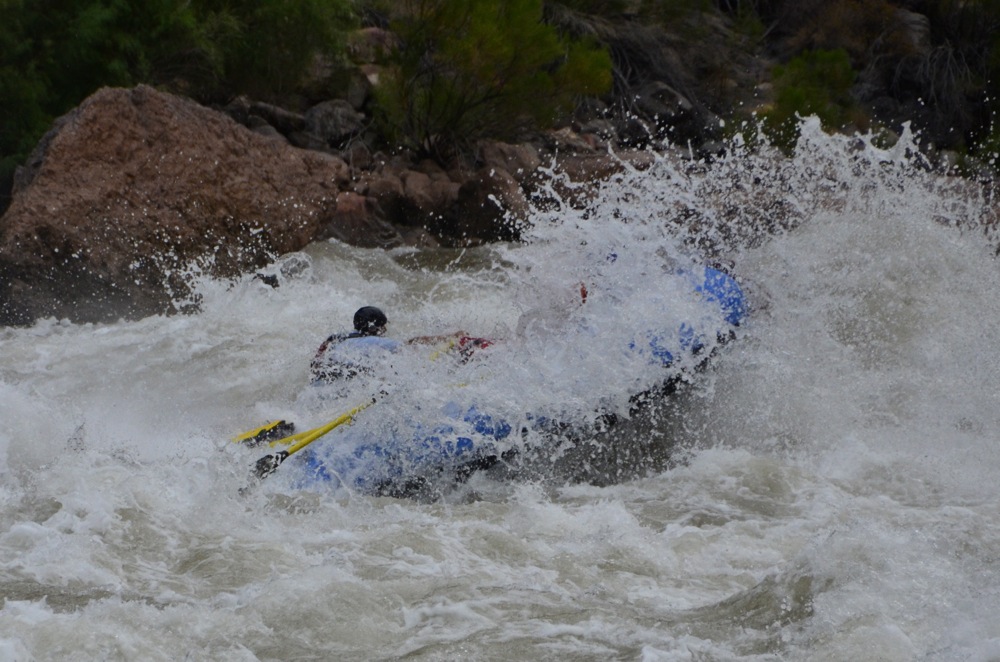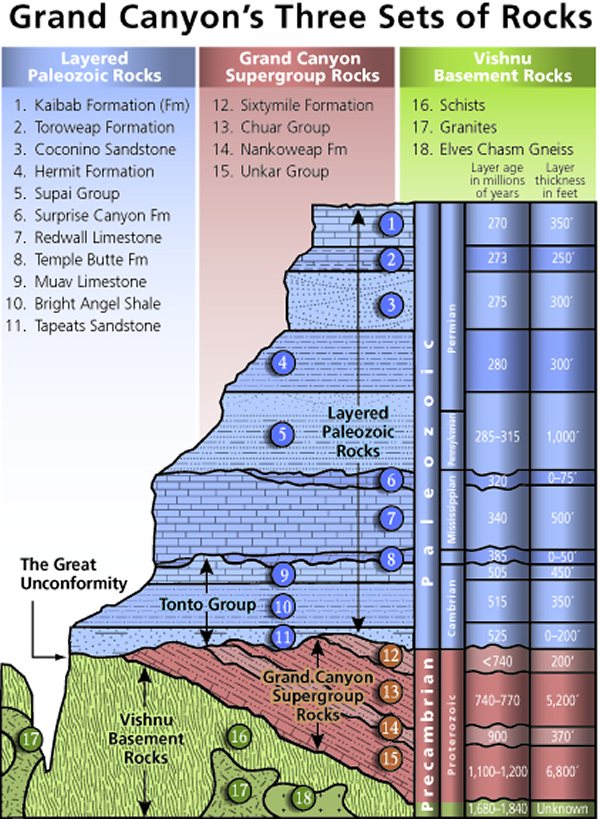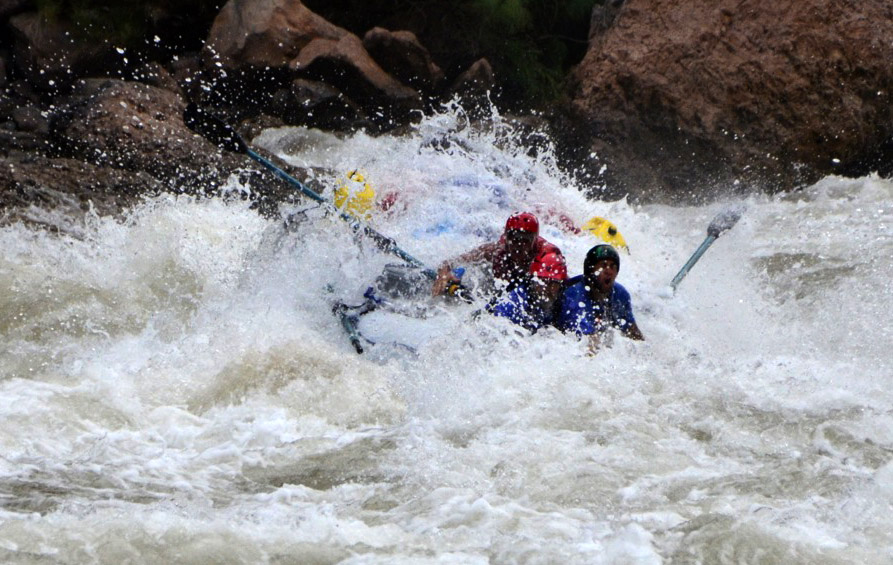The creationist ship is foundering.

In parts one and two we examined the young-earth creationist claim that the Great Unconformity in Grand Canyon was carved by the onset of Noah’s Flood. Today we’ll take this a step further, and explain what we would expect to see if the creationist story were true.
It turns out that geologists have a fair idea of what gigantic floods do to the surface of the earth. We can look at a couple places in the world, particularly in eastern Washington State, and see evidence for giant—though not worldwide—movements of water.
The Missoula Floods of eastern Washington were a series of vast deluges that occurred between about thirteen and fifteen thousand years ago. Perhaps as many as forty separate times, an ice dam holding back an estimated five hundred trillion gallons of glacial meltwater breached suddenly. (How much water is that? Think Lake Erie. Then multiply by four.) This water came from the melting ice sheet that once covered all of Canada. The resulting waters scoured the land from east to west across Washington, before finding the Columbia River Gorge and spending themselves into the Pacific.
Along the way, these Missoula Floods left distinct marks:
- giant erratic boulders perched in unlikely places
- huge “pothole” depressions carved into bedrock by the rotation of flood-energized boulders
- “dry falls”—imagine cliffs like Niagara Falls with no water flowing
These are the kind of features geologists know to look for when recognizing those rare places on earth where in the past immense quantities of water moved over very short times. Does Grand Canyon have these three?
When we look at the Great Unconformity, which marks the supposed onset of Noah’s Flood, we find no giant erratic boulders perched between layers. We find no huge potholes carved by the action of water. Likewise, we find no “dry falls” of the sort seen in eastern Washington. In short, all the features we expect to see from a giant flood are missing.
Moreover, many other features of Grand Canyon argue against its carving by Missoula-style flooding. The serpentine, meandering course of the Colorado River is typical of what we see when a low-lying river is tectonically raised rapidly, causing the river to incise the bedrock faster than the river can change its meandering shape. That’s how the modern Colorado looks. If Grand Canyon were carved by the retreating waters of Noah’s Flood, we would expect a channel much straighter, much less meandering than it is today. We would also expect broad, flat scoured areas rather than a deep channel.
It’s not just the lack of the characteristic features left by rapid massive floods that are the problem for the young-earth creationist view that the Great Unconformity marks the start of Noah’s Flood.

- If the Flood happened, the flat-lying Paleozoic rocks (blue) which sit above the Great Unconformity would be homogenized, with few distinct layers. The raging violence of Flood waters would mix together boulders and gravel and clay in an unsorted, inchoate mass. What we see: The opposite. Distinct layers with fine gradations and features.
- If the Flood happened, the boundaries between Paleozoic layers (blue) would be gradational rather than sharp, reflecting their origin in a constant rain of sediment during the year of the Flood. What we see: The opposite. Many layers end sharply, with no gradations.
- If the Flood happened, the Paleozoic rocks (blue) would contain a well-mixed suite of fossils, with fossils from the upper layers also existing in the deepest rocks. What we see: The opposite. There is a distinct order of fossils from top to bottom, which follows the order we see everywhere else in the world. We don’t find modern fossils at the bottom, nor ancient fossils at the top.
Nothing fits the creationist Flood model. As we now reach the end of the top five creationist claims about Grand Canyon, I hope one fact is as clear as Crystal Rapids: the rocks of Grand Canyon do not even remotely support creationist conjectures.
Geologists talk about “ground truth,” the observations you can only make out in the field when your boots are muddy and your heels are blistered. The ground truth in Grand Canyon smacks the young-earth creationist model like a crashing wave of ice-cold water in Lava Falls:

But in many ways, this doesn’t matter.
Facts won’t change creationist minds. Any scientist who thinks detailed geologic evidence is automatically going to convince creationists about Noah’s Flood simply does not understand creationists. No blog post or PowerPoint presentation or peer-reviewed article is guaranteed to spark an epiphany. Though scientists and science educators work in a world that assumes persuasion is possible using facts and knowledge, that kind of intellectual openness is slammed shut when it comes to creationists (among other groups).
The best way to understand this phenomenon is to hear it their own words. Kurt Wise, a young-earth creationist who earned a PhD at Harvard studying with the late Stephen Jay Gould, once wrote:
... if all the evidence in the universe turns against creationism, I would be the first to admit it, but I would still be a creationist because that is what the Word of God seems to indicate. Here I must stand.
This is a remarkable admission, one which can help us understand why the efforts of scientists and educators so frequently fail. The rejection of climate change, of evolution, of geologic time—scientists have tried and tried again to present facts on these topics, yet a stubborn percentage of the public refuses to be persuaded, even if “all the evidence” contradicts their view.

So as we reflect on the magnificent beauty of Grand Canyon, there is a note of sadness. There are real mysteries here, deep unanswered questions about how the canyon formed. Did the Marble Canyon section once flow the other way, as the direction of tributaries seems to indicate? What was the timing of its carving—five million years ago or ten times that? There’s evidence for both. These are interesting questions, questions visitors ought to contemplate.
What a great shame that so many who visit Grand Canyon never truly see it through the fog of the creationist interpretations they force upon the rocks, rocks which if approached with an open mind would whisper a tale very different from Noah’s Flood. The tale of Grand Canyon’s rocks is more epic than the Flood, filled with the rending of continents, of vast landscapes burred down to dust, of the life dramas of billions of animals now encased as silent sentinels mutely watching the joyful few lucky enough to venture into Grand Canyon’s depths. What a shame to behold the majesty of Grand Canyon but reject the science that helps us understand it. What a shame to go there and not truly see Grand Canyon.
